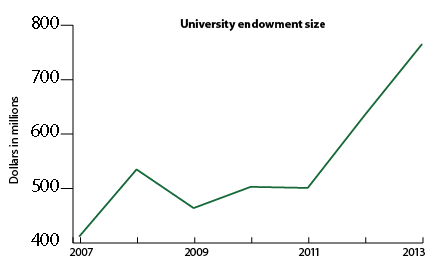In 2010, Chancellor Randy Woodson announced one of his goals for N.C. State was to raise the endowment to $1 billion. Since then, he has stayed on track to meet that goal.
According to Mary Peloquin-Dodd, associate vice chancellor for finance and business, in three years since the chancellor arrived at N.C. State, the endowment has increased from less than $400 million to $764.9 million, as of June 30, 2013. Friday’s massive $50 million grant from the Park Foundation should only increase that number.
“Through its exceptional generosity, the Park Foundation has demonstrated its passion for higher education, ensuring that the life-changing gift of an N.C. State education will be available to promising young men and women now and well into the future,” Chancellor Randy Woodson said in a press release Friday.
Last year, donors added a record-breaking $129.6 million to the endowment.
Laurie Reinhardt-Plotnik, associate vice chancellor for development at N.C. State, said building N.C. State’s endowment is a chief institutional priority.
“As state and federal funding for public higher education decreases, private support must increase,” Reinhardt-Plotnik said. “A large endowment is key, because this provides a regular source of financial support for the university.”
Woodson also highlighted the importance of a large endowment.
“During this challenging economic time when our university has experienced significant budget cuts, this [Park Foundation] gift is especially meaningful,” Woodson said in a press release Friday.
Reinhardt-Plotnick said a university endowment consists of money donated to the University by various groups or people which is then invested. The endowment itself is not spent, but a small percentage is available each year, taken as investment income.
“All great universities have endowments,” said Reinhardt-Plotnik. “Think of a savings account with interest – just the interest is spent, not the savings.”
Peloquin-Dodd said there are two things that grow an endowment: fundraising and investment performance.
“Since the chancellor came, a concerted effort was made on the chancellor’s part to try and improve the endowment,” Peloquin-Dodd said. “Since the fiscal crisis, in some years, the investment performance has not been so good. A large part of the growth has been the chancellor’s efforts to improve fundraising.”
Reinhardt-Plotnik said the income provided by the endowment investments each year is used to support key university priorities.
“Our chancellor, provost, and academic and administrative leaders help to identify these priorities,” Reinhardt-Plotnik said.
Peloquin-Dodd said donors can also choose to direct their gifts to specific purposes. Common designations for endowments are scholarships and fellowships for students, faculty positions, research projects and academic programs such as study abroad. The Park Foundation restricted its $50 million gift on Friday to the Park Scholarship program.
“The vast majority of our endowment is restricted,” Peloquin-Dodd said. “The $764.9 million we gave … are all the aggregated endowments from across the university.”
Peloquin-Dodd said endowment size has very little to do with graduation rates.
“The universities with the biggest endowments generally have the best alumni giving rates and what’s called participation rates – not just class participation – but participation of alumni across the university,” Peloquin-Dodd said. “Universities with the biggest endowments also generally have the highest alumni participation rates.”
Still, Reinhardt-Plotnik said she is optimistic about the future of the endowment, based on donors’ changing behavior since Woodson’s arrival.
“We are having regular discussions with our donors about the importance of gifts to endowment,” Reinhardt-Plotnik said. “And donors are stepping up, giving increasingly to endowment priorities across campus.”








